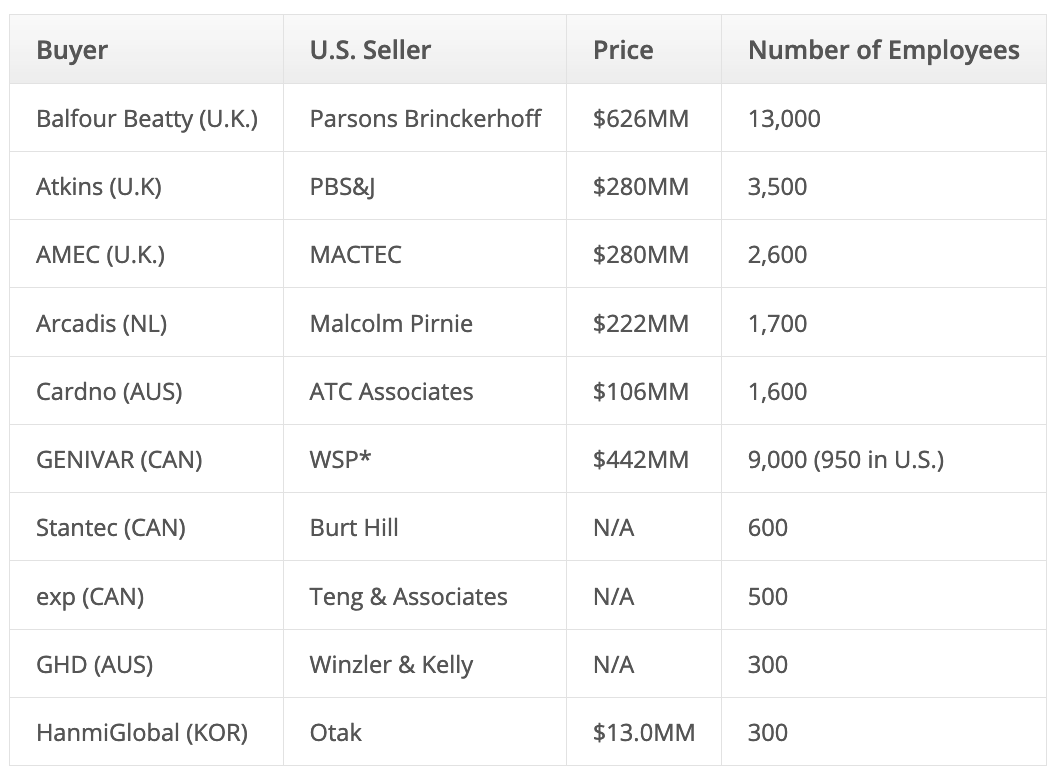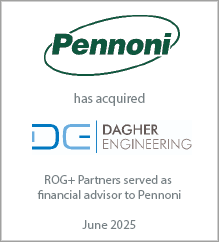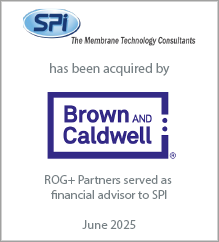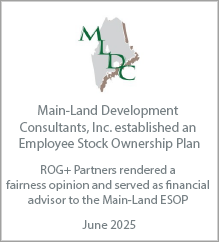Steve Gido specializes in corporate financial advisory services with a focus on mergers and acquisitions. Steve has assisted architecture, engineering, environmental consulting and construction firms of all sizes across North America achieve their growth or liquidity goals through successful mergers & acquisitions. Steve has over 15 years of investment banking experience and holds the chartered financial analyst (CFA) designation from the CFA Institute.
2013 M&A Outlook – It’s a Small World (After All)
March 5, 2013
Last year I had a lengthy telephone chat with a friend of mine who happens to be the President of a mid-sized environmental consulting firm. Throughout the course of our discussion, he listed various anxieties and opportunities and wondered aloud if his business challenges were unique to his organization. At the end, he mentioned several competitors he thought he could outmaneuver that year.
When he uttered the name of his last opponent, I brought to his attention that the firm was acquired a month earlier by a sizable multi-disciplined organization from Australia.
He responded, “Who are they?”
When I shared with him their name and background he paused for bit and then replied, “Why in the world would they buy them?”
* * *
Indeed. 15 years ago it was a rarity if an international A/E firm courted, much less even acquired, a company here in the United States. Historically, wide cultural differences, disparate business practices, limited technology and telecommunication infrastructures, litigation stigma, a strong dollar, and simple risk vs. return alone kept buyers from aggressively “coming ashore.”
However, with each passing year since, slowly but steadily they have come. The Canadians. The Europeans. The Australians. The U.S. real estate and construction boom of the 2000s helped accelerate it. Big deals and small deals have taken place across every discipline – architecture, engineering, environmental, and construction. Company names that many had never heard of in the 1990s are now firmly part of the U.S. competitive landscape and industry lexicon. In fact, with many of our firm sale engagements, we prepare clients that it’s increasingly likely they could end up selling to an unknown, although growth-oriented, international A/E buyer. Ten years ago that possibility was barely a consideration. The table below highlights some of the more prominent cross border industry deals the last five years, but these are the tip of the iceberg:
When he uttered the name of his last opponent, I brought to his attention that the firm was acquired a month earlier by a sizable multi-disciplined organization from Australia.
He responded, “Who are they?”
When I shared with him their name and background he paused for bit and then replied, “Why in the world would they buy them?”
* * *
Indeed. 15 years ago it was a rarity if an international A/E firm courted, much less even acquired, a company here in the United States. Historically, wide cultural differences, disparate business practices, limited technology and telecommunication infrastructures, litigation stigma, a strong dollar, and simple risk vs. return alone kept buyers from aggressively “coming ashore.”
However, with each passing year since, slowly but steadily they have come. The Canadians. The Europeans. The Australians. The U.S. real estate and construction boom of the 2000s helped accelerate it. Big deals and small deals have taken place across every discipline – architecture, engineering, environmental, and construction. Company names that many had never heard of in the 1990s are now firmly part of the U.S. competitive landscape and industry lexicon. In fact, with many of our firm sale engagements, we prepare clients that it’s increasingly likely they could end up selling to an unknown, although growth-oriented, international A/E buyer. Ten years ago that possibility was barely a consideration. The table below highlights some of the more prominent cross border industry deals the last five years, but these are the tip of the iceberg:
*WSP is U.K.-based with significant U.S. operations
These international firms are here for much the same reason 16th century explorers sought out the “New World” – new opportunities (although back then they called it “riches”). With many overseas design and infrastructure domestic markets mature or slowing, these global entities have come to view the United States, with its 300 million+ inhabitants, voracious building and risk taking appetite, and perennial D-grade infrastructure ratings, as fertile ground to plant the flag. As much as we think of our own A/E or environmental markets as local, regional or even multi-regional, it’s increasingly global. And the trend shows no signs of slowing down.
As such, a number of A/E owners have been wined and dined by global executives with different accents, business references (to some, turnover is revenue and not architect churn), and industry best practices and philosophies. For global suitors, they understand the time and coordination needed to build a U.S operation from scratch is not an option, or rather a limited one.
For sellers, some have realized they are either not on the radar screens of the large U.S. publicly traded or privately-held buyers anymore (as those organizations have gone searching for targets overseas themselves – a tale for another time) or simply would prefer not to sell to those groups for cultural or competitive reasons. Global buyers have often promised (with elements of both truth and wishful thinking) that sellers would be able to operate and integrate on a relatively “stand-alone” basis with the support of their new foreign parent some five time zones away. Add to the equation that global firms have often arrived paying higher multiples than U.S. suitors or private equity firms as well as offering large, up-front cash deals. As a result, it’s made for a number of eager marriages!
Some opined that when the recession hit, the international firms might reduce their U.S. exposure and begin to curb their appetites here. In fact, the opposite has happened. Global A/E CEOs we speak with say they still view the U.S. as “high market potential” with “enormous needs” and having “world class schools and talent.” Despite the lingering recession here, they want access to U.S. multi-national companies and federal and state agencies for growth and diversity. Our discussions with U.S. leaders who recently sold to their European or Canadian counterparts have shared a more patient, longer-term approach these organizations often take in building out their worldwide franchises.
That’s not to say that all these transactions have turned out rosy. A/E cross border deals are just as ripe to executive and staff turnover, poor due diligence, cultural and communication challenges, turf battles and egos, and bad strategic intent. There’s still one universal mantra all buyers can understand – caveat emptor!
* * *
As we reported in December, 2012 M&A activity ended on a high note, aided by a healthy amount of year-end tax driven selling. By our tracking, the number of transactions was up 15% over 2011 levels. Although the number of U.S. sellers only ticked up by 4%, international targets surged over 50%. Many global and domestic A/E firms continue to seek international targets in emerging economies (China, Middle East, India) and/or mining and energy rich regions (South America, Canada, Australia, etc.).
As for 2013, we believe industry M&A activity will be flat to slightly down for the year. The combination of the strong transaction year in 2012 means that many A/E management teams are spending the first part of 2013 digesting and integrating these recent purchases. And while many favorable deal making elements remain in place (stronger balance sheets, cheap acquisition financing, lackluster organic prospects, dire need for exit strategies, etc.), our recent conversations with industry executives and M&A participants suggest the need to perhaps “take a breather.” Others want to see sustained traction on the industry and overall economic recovery fronts before committing time and resources to deals.
At ROG+ Partners, we possess strong relationships and years of experience navigating A/E and environmental buyers and sellers through the M&A process and towards winning combinations. Whether you are seeking to grow through acquisitions or by evaluating your firm’s strategic and ownership alternatives, please contact us as to how we can help your organization.
These international firms are here for much the same reason 16th century explorers sought out the “New World” – new opportunities (although back then they called it “riches”). With many overseas design and infrastructure domestic markets mature or slowing, these global entities have come to view the United States, with its 300 million+ inhabitants, voracious building and risk taking appetite, and perennial D-grade infrastructure ratings, as fertile ground to plant the flag. As much as we think of our own A/E or environmental markets as local, regional or even multi-regional, it’s increasingly global. And the trend shows no signs of slowing down.
As such, a number of A/E owners have been wined and dined by global executives with different accents, business references (to some, turnover is revenue and not architect churn), and industry best practices and philosophies. For global suitors, they understand the time and coordination needed to build a U.S operation from scratch is not an option, or rather a limited one.
For sellers, some have realized they are either not on the radar screens of the large U.S. publicly traded or privately-held buyers anymore (as those organizations have gone searching for targets overseas themselves – a tale for another time) or simply would prefer not to sell to those groups for cultural or competitive reasons. Global buyers have often promised (with elements of both truth and wishful thinking) that sellers would be able to operate and integrate on a relatively “stand-alone” basis with the support of their new foreign parent some five time zones away. Add to the equation that global firms have often arrived paying higher multiples than U.S. suitors or private equity firms as well as offering large, up-front cash deals. As a result, it’s made for a number of eager marriages!
Some opined that when the recession hit, the international firms might reduce their U.S. exposure and begin to curb their appetites here. In fact, the opposite has happened. Global A/E CEOs we speak with say they still view the U.S. as “high market potential” with “enormous needs” and having “world class schools and talent.” Despite the lingering recession here, they want access to U.S. multi-national companies and federal and state agencies for growth and diversity. Our discussions with U.S. leaders who recently sold to their European or Canadian counterparts have shared a more patient, longer-term approach these organizations often take in building out their worldwide franchises.
That’s not to say that all these transactions have turned out rosy. A/E cross border deals are just as ripe to executive and staff turnover, poor due diligence, cultural and communication challenges, turf battles and egos, and bad strategic intent. There’s still one universal mantra all buyers can understand – caveat emptor!
* * *
As we reported in December, 2012 M&A activity ended on a high note, aided by a healthy amount of year-end tax driven selling. By our tracking, the number of transactions was up 15% over 2011 levels. Although the number of U.S. sellers only ticked up by 4%, international targets surged over 50%. Many global and domestic A/E firms continue to seek international targets in emerging economies (China, Middle East, India) and/or mining and energy rich regions (South America, Canada, Australia, etc.).
As for 2013, we believe industry M&A activity will be flat to slightly down for the year. The combination of the strong transaction year in 2012 means that many A/E management teams are spending the first part of 2013 digesting and integrating these recent purchases. And while many favorable deal making elements remain in place (stronger balance sheets, cheap acquisition financing, lackluster organic prospects, dire need for exit strategies, etc.), our recent conversations with industry executives and M&A participants suggest the need to perhaps “take a breather.” Others want to see sustained traction on the industry and overall economic recovery fronts before committing time and resources to deals.
At ROG+ Partners, we possess strong relationships and years of experience navigating A/E and environmental buyers and sellers through the M&A process and towards winning combinations. Whether you are seeking to grow through acquisitions or by evaluating your firm’s strategic and ownership alternatives, please contact us as to how we can help your organization.









